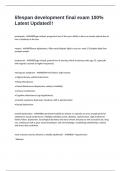lifespan development final exam 100%
Latest Updated!!
presbyopia - ANSWERSage-related, progressive loss of the eyes' ability to focus on nearby objects due to
loss of elasticity in the lens
myopia - ANSWERSnear-sightedness. Often need brighter light to see too- need 1/3 brighter light than
younger people.
presbycusis - ANSWERSage-related, gradual loss of hearing, which accelerates after age 55, especially
with regard to sounds at higher frequencies
menopause symptoms - ANSWERS• Hot flashes/ night sweats
• Vaginal dryness, painful intercourse
• Sleep disturbances
• Mood disturbances (depression, anxiety, irritability)
• Urinary incontinence
• Cognitive disturbances (eg forgetfulness)
• Somatic symptoms (back pain, tiredness, stiff or painful joints)
• Sexual dysfunction
erectile dysfunction - ANSWERSa persistent inability to achieve or maintain an erect enough penis for
satisfactory sexual performance. Multiple potential causes: diabetes, hypertension, high cholesterol,
kidney failure, depression, neurological disorders and many chronic diseases as well as alcohol use, drug
use, smoking as well as poor sexual techniques, lack of knowledge, unsatisfying relationships, anxiety
and stress may contribute
most common chronic ailments in middle adulthood? - ANSWERS* hypertension
*diabetes
, hypertension - ANSWERSincreasingly important concern for midlife on as a risk factor for cardiovascular
disease and kidney disease. Consuming vegetable protein tends to lower BP, impatience and hostility
increase long-term risk of development hypertension. It can be controlled through BP screening, low-salt
diet and medication. Number of diagnoses have increased but death rates have decreased.
diabetes - ANSWERS: prevalence doubled in 1990s. mature onset type 2 diabetes typically develops after
age 30 and more prevalent with age. Glucose levels rise because the cells lose their ability to use the
insulin the body produces and as a result, the body compensates by producing too much insulin. People
typically don't realize they have it until something serious happens such as heart disease, stroke,
blindness, kidney disease or loss of limbs.
Leading causes of death in middle adulthood: - ANSWERScancer
hypertension
behavioral influences on health - ANSWERSnutrition, smoking, alcohol, drug use and physical activity.
Americans who smoke, are overweight, and have high BP and high blood sugar have a life expectancy 4
years less than those who do not
What impact does Race/ ethnicity have on health? - ANSWERSVariations in DNA codes amongst different
races are linked to predispositions to various diseases, cancer, obesity etc. factors may occur as a
consequence of lower likelihoods of participating in regular, moderate physical activity. Much less likely
to have health insurance and a regular source of health care if they are limited in English. Also are less
likely to be screened for cholesterol and for breast, cervical, and colorectal cancers, or to receive
influenza and pneumonia vaccines.
the impact of stress on health - ANSWERSStress: response to physical or psychological demands. The
body's capacity to adapt to stress involves the brain, which perceives danger; the adrenal glands, which
mobilize the body to fight it; and the immune system which provides the defenses.
how is adult intelligence measured? - ANSWERSVerbal meaning (recognition and understanding of
words), word fluency (retrieving words from long-term memory), number (performing computations),
spatial orientation (manipulating objects mentally in 2D space), inductive reasoning (identifying patterns
and inferring principles and rules for solving logical problems) and perceptual speed (making quick,
accurate discriminations between visual stimuli).




